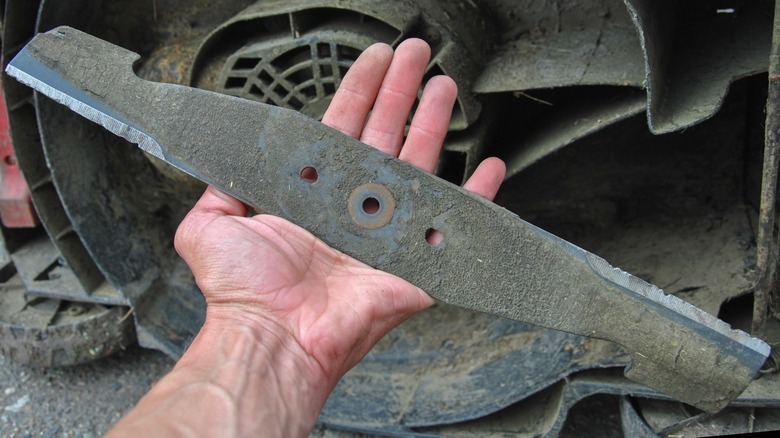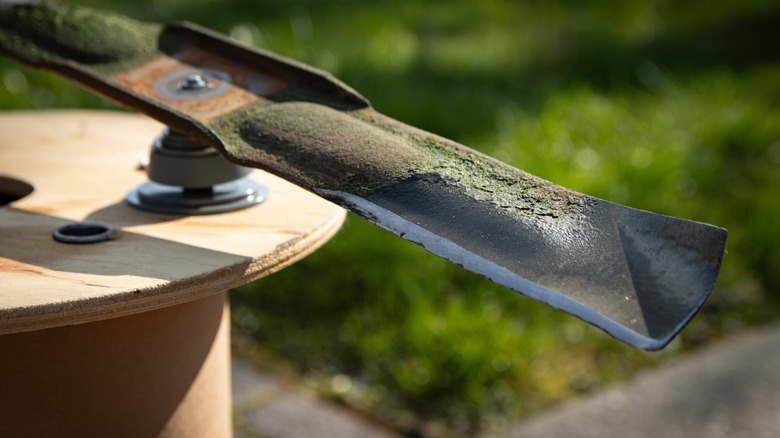How To Balance Your Lawn Mower Blades After Sharpening Them (And Why It Matters)
We may receive a commission on purchases made from links.
You can choose whichever tool for sharpening dull lawn mower blades that you like, but the final step before reinstalling them on your lawn mower should be balancing the blades. Using unbalanced lawn mower blades can lead to excessive vibration as the blade, or blades, spin rapidly while cutting grass. This can lead to ruined bearings inside the mower deck of riding mowers and lawn tractors alike and damage the crankshaft and associated engine bearings of vertical-shaft push mowers. The vibration of unbalanced blades can also make the chore of mowing the lawn more uncomfortable than it needs to be.
Another common cause for concern when maintaining your lawn mower blades is identifying blades that have become bent. While it's possible to balance a bent blade, using it to mow a lawn will result in an uneven cut and could also damage your mower deck. The good news is that there are a number of ways to balance your lawn mower blades and check them for straightness that only cost a few bucks.
Balancing your lawn mower blades is DIY friendly
Getting the blades off your lawn mower and sharpening them is the hard part; balancing them is easy by comparison. There are a few proven methods for balancing lawn mower blades, but before we dive into those, it's important to clean any grass and dirt from the blades using a wire brush or a wire wheel if it's really stuck onto the blade.
While you should perform an inspection before sharpening them, sometimes defects that require replacing lawn mower blades sooner than normal won't appear until after sharpening. These defects include cracks, bends, and overly worn cutting or trailing edges of the blade. Once the blades are clean and visually free from defects, it's time to balance them.
Some DIY methods for balancing lawn mower blades involve suspending the blade from the center hole on a nail driven into a vertical surface, such as a post. While this will indicate a severely out-of-balance blade, it's not precise enough to eliminate the risk of damaging vibration. It's better to use a tool designed for balancing lawn mower blades.
Using the right tool to balance lawn mower blades
One of the simplest ways to accurately balance some lawn mower blades is by using a stepped-cone blade balancer, like the Oregon Precision Mower Blade Balancer, typically priced at $8.49 on Amazon. If your blade has a hole that fits onto one of the steps, this balancer will do a fine job of indicating which side of the blade is heavy or if they're equally balanced.
If your blades do not fit the steps of the simple tool above, you should consider the Erdle Lawn Mower Blade Balancer Magnetic Wall Mount 42-047, priced at $28.89 on Amazon. Its unique design uses a tapered cone, instead of steps, surrounded by a ring of six magnets to hold the mower blade vertically centered on the cone. In this orientation, the heavy side of the blade rotates downward, while a balanced blade stays horizontal. The Erdle balancer also comes with a handy probe to simplify checking the blade's straightness.
Whichever method you use to check the blade's balance, adjusting it requires grinding or filing away a little more metal from the heavy side. Remove the metal by sharpening the cutting edge of the blade on the heavier side a little at a time, checking its balance frequently. Never remove metal from any other portion of the lawn mower blade.
After the clean, freshly sharpened mower blades are perfectly balanced, it's a good idea to spray them with WD-40 to extend their life. Then, it's just a matter of reinstalling them using the same methods employed to remove them from the mower.


